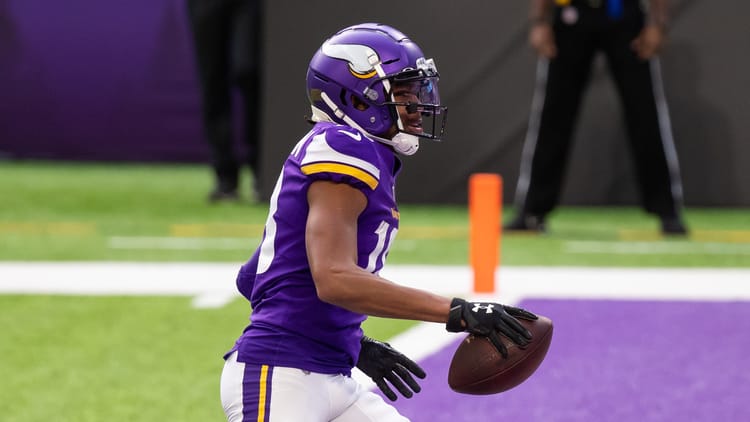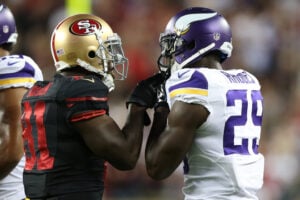What to Expect from Justin Jefferson in Year Two

The Minnesota Vikings tend to play a gridiron version of Russian Roulette with the WR3 position, so the outlook for Justin Jefferson’s sophomore season is of the utmost importance. If something happens to him injury-wise or his running mate, Adam Thielen, Minnesota’s offense will endure a gut-punch because the drop-off to WR3 shifts from a talent perspective. In other NFL offenses, the WR3 often receives the nod when injuries surface to fill WR2 shoes – and glints. It feels like a matter of survival on the WR2-into-WR3 slope if Jefferson or Thielen is lost.
Jefferson’s second-year prognostication can only be speculated. And history is the best source to reference, implying future performance.
The rookie receiving yards record was shattered by Jefferson in 2020, totaling 1,400 yards and seven touchdowns. En route to that distinction, Jefferson plowed past Odell Beckham, Randy Moss, and Anquan Boldin.
Here’s a look at how those men fared in their respective second seasons.
Odell Beckham
Rookie = 91 Rec / 1,305 Rec Yds / 12 TDs
Sophomore = 96 Rec / 1,450 Rec Yds / 13 TDs
11% Yds INCREASE / 8% TD INCREASE

The Rhodes were closed for Odell Beckham Jr. and the Giants in Week 4. (Vikings.com)
2015 Odell Beckham was better than 2014 Odell Beckham. Whooda thunk it?
On a not-very-good team, Beckham and the Giants finished 6-10 in his second act. Beckham gathered 28 more targets that year from Eli Manning compared to his rookie season. And he made the most of those targets.
The LSU alumnus (same school as Jefferson) increased his receiving yards and touchdowns, further cementing his status as a household-name wide receiver. Beckham’s first three years were his glory days as the seasons proceeding 2016 have been marred by injury.
But as an example for sophomore improvement, Beckham improved the most of these three men – a tendency Jefferson seeks to replicate.
Randy Moss
Rookie = 69 Rec / 1,313 Rec Yds / 17 TDs
Sophomore = 80 Rec / 1,413 Rec Yds / 11 TDs
8% Yds INCREASE / 35% TD DECREASE

Photo courtesy of vikings.com
Moss morphed into a more prototypical WR1 in 1999. His rookie season was that of acrobatic legend, breaking [and keeping 23 years later] the rookie record for touchdowns scored by a pass-catcher. With Randall Cunnigham and Jeff Geroge at the helm, Moss nestled into his fateful role of superstar wide receiver. Not only was he heaved deep balls, Moss began snagging “normal” catches like his pal, Cris Carter.
He was targeted 13 more times in 1999 than 1998, dropping his yards-per-catch by a whisker while spiking his receiving yards. The 17-TD total would not return until 2003, Moss’ last fully healthy season with the Vikings.
Anquan Boldin
Rookie = 101 Rec / 1,377 Rec Yds / 8 TDs
Sophomore = 56 Rec / 623 Rec Yds / 1 TD
55% Yds DECREASE / 88% TD DECREASE

Image Courtesy of Zimbio.com
Never a touchdown aficionado like the aforementioned Moss – which is probably why Moss remains more legendary — Boldin did tear it up in his rookie season. He’s the player that Jefferson stole the record from in 2020.
Boldin’s large dip in 2004 was caused by injury. He missed six full games, shedding his targets from 165 in 2003 to 104 in 2004. His production was destined to plummet with a reduced target load. Interestingly, Boldin’s sophomore year in 2004 was coached by Dennis Green, who spent 10 years as the skipper of the Vikings.
After the injury-riddled 2004 campaign, Boldin rebounded in 2005 with the best season of his career, hauling in 1,402 receiving yards and seven scores. Arizona finished the year 5-11.
The Verdict
If Boldin’s injury is subtracted from the equation, instead acknowledging his 2004 season by per-game totals, this is approximately what Jefferson has in store based on history:
97 Receptions / 1,500 Receiving Yards / 6 TDs

You must be logged in to post a comment.